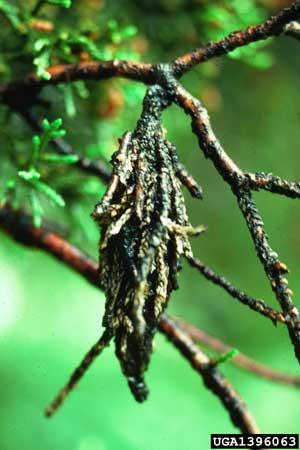Bagworms are small, dirt-brown colored caterpillars, which are sometimes difficult to see. They disguise themselves with parts of the shrubs and foliage they eat by forming a spindle-shaped bag that measures 1 1/2 to 2 1/2 inches in length. The bag is formed by gluing parts of leaves together with silk, and carried along with the caterpillar as it feeds. As the larvae grow, the bag grows with it and when disturbed, the larvae will hide inside.
Bagworms feed on many conifers and deciduous trees. They are especially fond of arborvitae, juniper and cedar.
Female bagworm larvae cannot fly, so populations may build up on trees. When this occurs, crowded larvae may eat the buds, causing branch dieback and large open dead areas. Older larvae strip evergreens of their needles and consume whole leaves of susceptible deciduous species, leaving only the larger veins. Moderate amounts of defoliation can be unsightly, but excessive amounts may result in severe Damage (even death) to the tree the following season.

Add your voice! Click below to comment. ThriftyFun is powered by your wisdom!